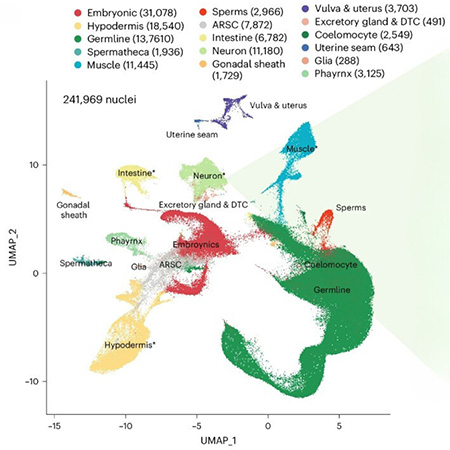Researchers have profiled gene expression in each cell of adult roundworms at different times during the aging process for both wildtype and long-lived strains, creating a complete transcriptomic cell atlas of aging in roundworms. Credit: Wang Lab
A new aging atlas gives scientists an in-depth view of how individual cells and tissues in worms age and how different lifespan-extending strategies might stop the clock.
Aging impacts all the tissues in our body – from our muscles to our skin. Figuring out how individual tissues and cells age could help researchers better understand the aging process and aid in the development of anti-aging treatments.
Due to their short lifespans, simple body plans, and genetic similarity to humans, many researchers study aging in roundworms. To look at aging at the level of tissues and cells, a team of researchers from Janelia, Baylor College of Medicine, and Creighton University School of Medicine profiled gene expression in each cell of adult roundworms at different times during the aging process. They also profiled long-lived strains of worms.

The researchers compiled their results into a complete transcriptomic cell atlas of aging in roundworms. The open-access atlas allows scientists to look at what genes are being expressed in all the worm’s cells at the same time and how gene expression changes over time, both for wildtype worms and worms with extended lifespans.
Using the atlas, the researchers developed tissue-specific “aging clocks,” predictive models they used to tease out the unique aging features of different tissues. The researchers used these clocks to better understand the anti-aging mechanisms in long-lived strains of worms.

The researchers also built the first germ cell fate trajectory map that follows how reproductive cells develop over time, enabling the team to discover age-related changes in cell makeup and gene expression in different stages of reproductive cells.
The atlas also allowed the team to get a view of polyadenylation, a key mechanism for gene regulation and protein diversification, across the entire worm as it aged. They discovered a series of age-related changes in these events in different cell types, suggesting a previously unknown link between this mechanism and aging.
The new findings not only give researchers insight into aging on the molecular level, but the new open-access atlas and accompanying user-friendly data portal also serve as a resource for other researchers.
###
Shihong Max Gao, Yanyan Qi, Qinghao Zhang, Youchen Guan, Yi-Tang Lee, Lang Ding, Lihua Wang, Aaron S. Mohammed, Hongjie Li, Yusi Fu & Meng C. Wang. “Aging atlas reveals cell-type-specific effects of pro-longevity strategies.” Nature Aging. Published May 30, 2024. DOI: 10.1038/s43587-024-00631-1
Media Contacts
Nanci Bompey





